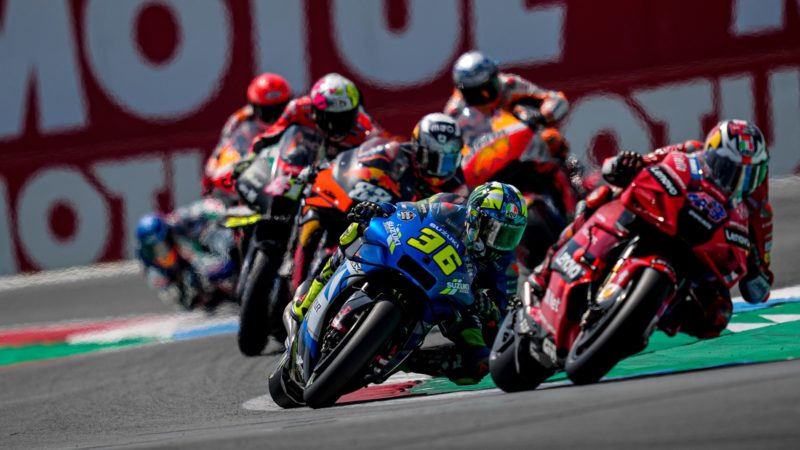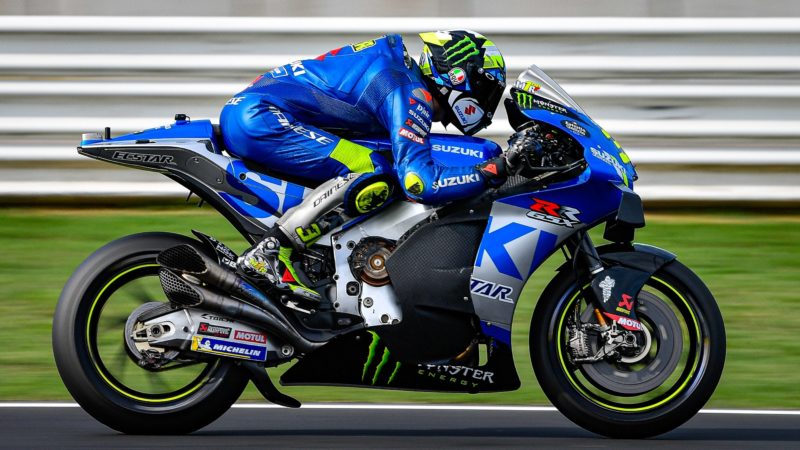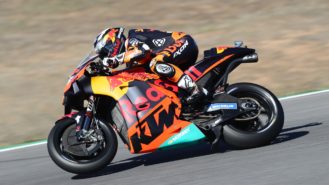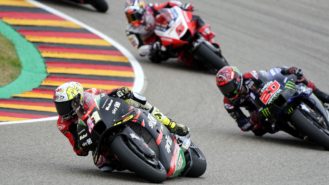Suzuki’s straight-line problems – even if they are reduced – will most likely be exacerbated by the presence of no less than eight Ducatis on the grid.
“Overtaking only one Ducati is a nightmare,” says Mir. “It’s difficult to overtake another bike when you have the same horsepower, so imagine what it’s like if you don’t have the same power. It’s always a big challenge. Last year I lost out to Ducati riders a lot of times and I lost a couple of races like this, so it’s frustrating.”
This explains (but doesn’t exonerate) Mir’s habit of riding into Ducati rivals!
“To stay in front of a Ducati you have to make a big gap on him before the next straight,” says Mir’s crew chief Frankie Carchedie. “Fair play to Fabio, because he gets to the front and he’s gone. If you don’t do that the race goes from you.”
Fabio Quartararo, whose inline-four Yamaha YZR-M1 suffers a similar straight-line handicap to the GSX-RR, was able to win the 2021 world title because the M1 helped him to qualify well.
The Frenchman scored 13 front-row starts (including five pole positions) and one second row at the 14 races it took him to win the title, so he could get out front and use the M1’s corner speed to build enough of a gap to keep the V4s behind him.
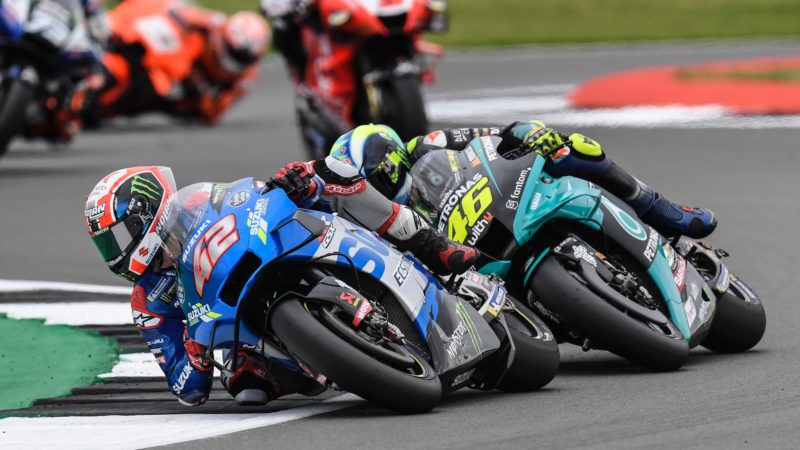
Rins scored his only 2021 podium at Silverstone, after getting the better of Valentino Rossi
Suzuki
Therefore you could argue that qualifying is Suzuki’s biggest problem.
Mir scored just one front row and two second rows at last year’s 18 races. Most of the time he started from the third or fourth rows and sometimes from the fifth or sixth. Meanwhile Rins achieved one front row and one second, but was mostly on the third, fourth and fifth.
“This is why at the moment Saturday is more stressful than Sunday for us,” adds Sahara.
A lowly grid position usually presents an impossible challenge on Sunday afternoon because overtaking in MotoGP only gets more difficult as bikes and riders get better and the gaps diminish.
“We modified the bike quite a bit in the second part of last season and the signs are positive”
It also requires the riders to take huge risks attacking their rivals. Mir is very good at this, even though it doesn’t make him the most popular man on track.
“Last season Joan made 90% of his overtakes in the first laps when everyone was settling down, or the last 15 or 20% of the race when everyone’s tyres were dropping,” adds Carchedie. “At lots of races we had the pace of the winner, if not slightly better, but the problem is that we were coming from so far back that the races were very difficult.”
Suzuki has struggled in qualifying because for some reason the GSX-RR doesn’t transform the extra grip available during time attacks – from softer tyres and different machine settings – into quicker lap times.
“In qualifying you want to really exploit the rear tyre and finish it in two or three laps,” Carchedie continues. “Our problem is that when we do use the tyre more aggressively we do exactly the same lap time, so we’re not exploiting the extra grip.”
In fact there is a glimmer of hope. Suzuki was MotoGP’s last factory to use a shapeshifter, which drops the rear of the bike exiting corners, thereby reducing wheelies, which is at least as important to straight-line speed as horsepower.
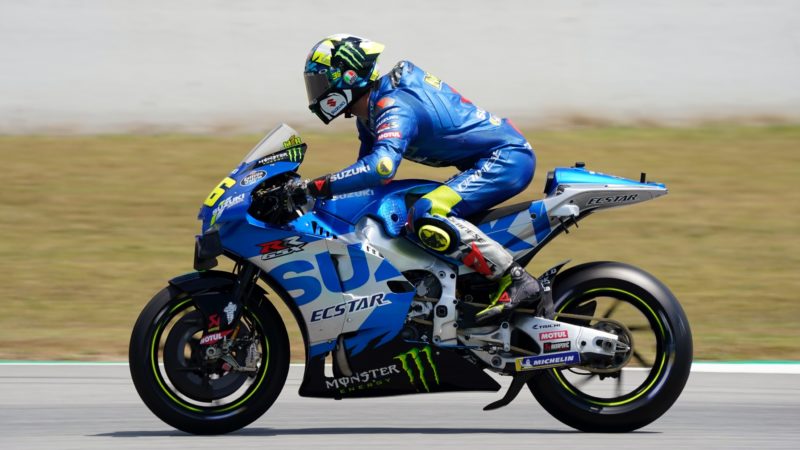
Flared leg supports on Mir’s GSX-RR’s tank assist his late-braking technique
Suzuki
Suzuki deployed its shapeshifter for the first time at Red Bull Ring last August, following the summer break. But the contraption needed lots of development, so Suzuki only raced it at Red Bull Ring, COTA and at the final two rounds, Portimao and Valencia, where a much-improved second-generation unit was used.
No surprise that Mir scored his four best grid slots at those races: fifth and seventh with the first generation, then third and fourth with the second. And no surprise that those races produced his best race results of the year, most notably second places at the Styrian GP, where he used the device for the first time and finished just 1.5 seconds behind Jorge Martin’s Ducati, and the Algarve GP.
This tells you all you need to know about the importance of shapeshifters, at a time when a tiny improvement in machine performance can make a big improvement in results.
“The signs are positive,” continues Carchedie. “We modified the bike quite a bit in the second part of last season and the shapeshifter gives us extra permutations in what we can do.”
Shapeshifters are worth two to three tenths per lap, which can make all the difference in qualifying and the race, but they are complex pieces of kit and not light, at several kilos, so it takes time to make them work right and not have a negative effect on the rest of the bike.
When Loris Capirossi rode Suzuki’s GSV-R MotoGP bike a decade or so ago he was given a revised exhaust to test. The new pipe weighed 150 grams more than the old pipe, but Capirossi immediately noticed its effect on bike dynamics, so imagine the effect several kilos can have on machine behaviour.
“The shapeshifter’s effect on acceleration is quite big but also the system is extra weight, so it changes the balance of the bike and last season we were still on our way to finding the ideal balance with the shapeshifter,” adds Sahara.
And because overall bike balance is what allows the GSX-RR to unleash its devastating corner speed and turning, this is an important consideration for Suzuki engineers.
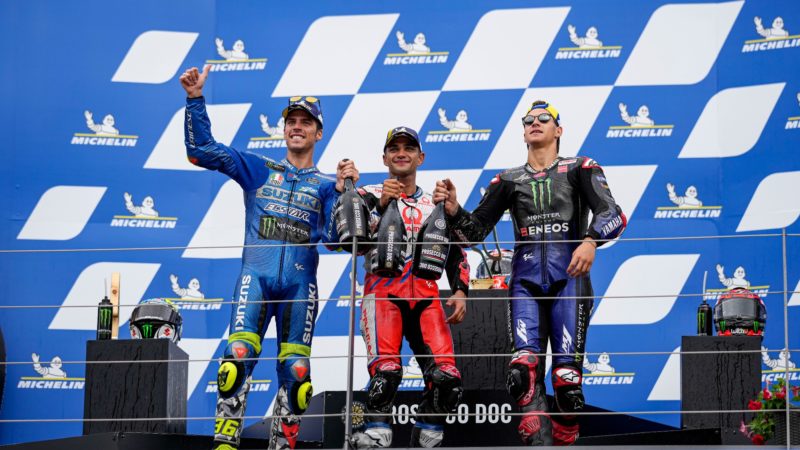
Mir has his best race at Red Bull Ring, chasing home winner Jorge Martin
Suzuki
Suzuki has added carbon-fibre to GSX-RR frames on and off since 2017, sometimes just to find a development direction with rigidity, because adding carbon to an existing frame is easier than fabricating an entirely new frame, other times to create a composite race frame with a particular character. However, believe it or not, even the extra weight of the carbon wrapping can upset the delicate balance required to get bike and rider dancing around on the tricky Michelins.
“When we wrap the frame in carbon-fibre we have more weight, and I’m not happy with more weight,” says Sahara. “Stiffness is the main aim with this wrapping, but it’s also useful to change other factors like the resonance character of the whole machine and how we transfer forces from the tyres to the chassis and to the handlebar, which is very important for us.”
The extra feel that this kind of super-detailed engineering work gives riders a cornering advantage because it allows them to take the tyres to the absolute limit of grip, because they know when they need to pull back from the brink.
